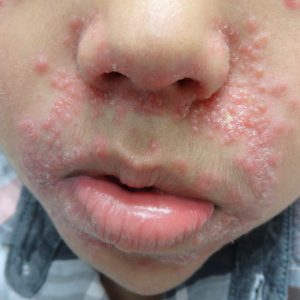Chapter 5: Acneiform Disorders
Periorificial Dermatitis
What is it?
Periorificial dermatitis is a common skin eruption on the face. It tends to occur most commonly in adult women, but also affects children of all ages. The exact cause of periorifical dermatitis is not known. In some cases, it may be triggered by the use of corticosteroids. These may be applied directly to the face, from unintentional contact after using the hands to apply a TCS elsewhere, or due to use of nebulized steroid.
What does it look like?
There are groups of small, pink to red papules and pinpoint pustules in the perioral, perinasal and/or periocular area. Sometimes the background skin is red or may have scale. Some patients report a burning sensation.
In contrast to rosacea, which can look similar, periorificial dermatitis spares the cheeks and forehead, and does not involve background telangiectasia or flushing.

How is it treated?
The treatment is very similar to that of rosacea. Topical treatments include calcineurin inhibitors, topical antibiotics, and/or azelaic acid. Oral tetracycline or macrolide antibiotics can be used for refractory cases for a 4-8 week course. Any topical corticosteroids being used on the face should be discontinued. If potent TCS are being used then these should be tapered slowly and replaced with a less potent agent to prevent a flare.

